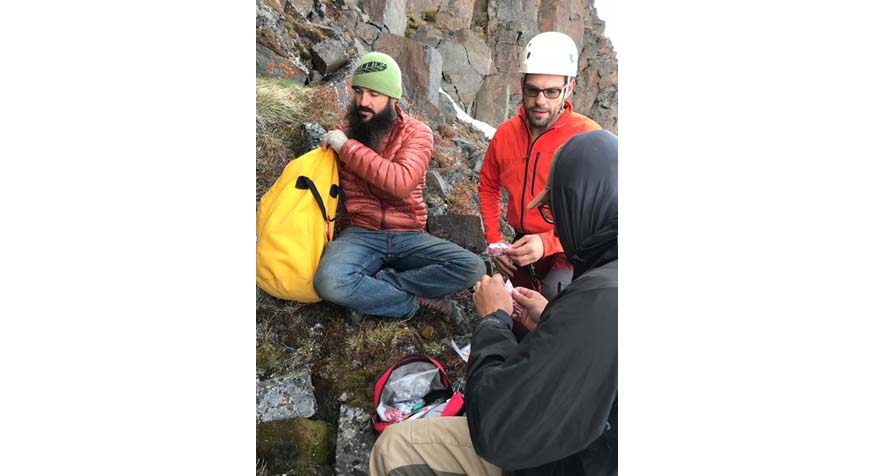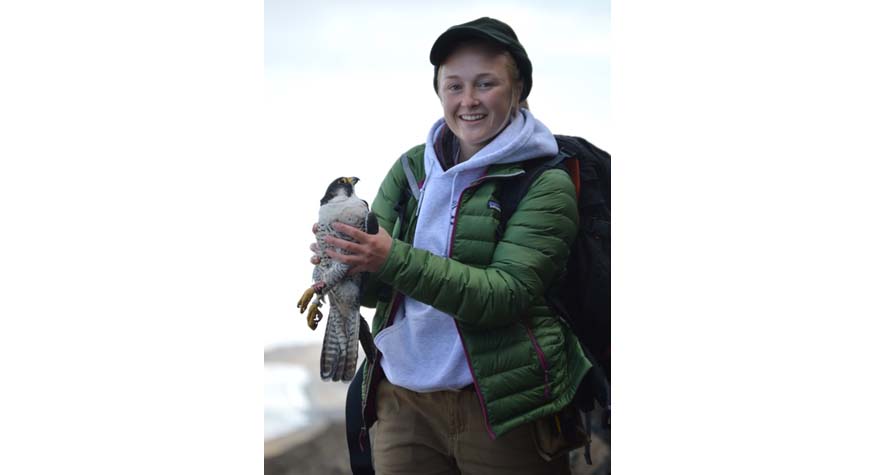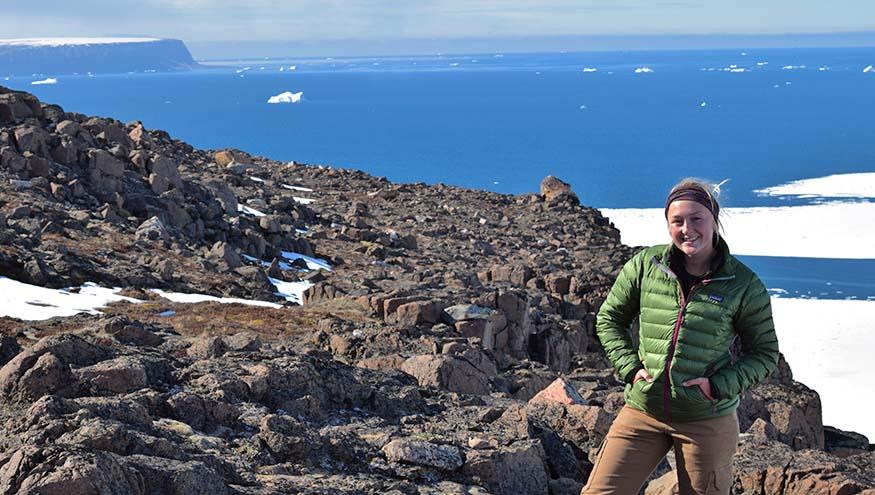
Bailey’s blog: Climbing cliffs and trapping birds
Senior Bailey Aasen is blogging from Greenland, where she is part of an Augustana field crew along with Dr. Jennifer Burnham of the geography department.
Aasen is from Cottage Grove, Minn. At Augustana, she plays lacrosse and is majoring in geography. She won the 2018 Scandinavian Studies Student Award for her paper, "The Greater Effects of Ocean Acidification: Shellfish in the Arctic."
Dr. Burnham has conducted research on birds and climate change in Greenland for many years, and is the director of the Center for Polar Studies at Augustana.
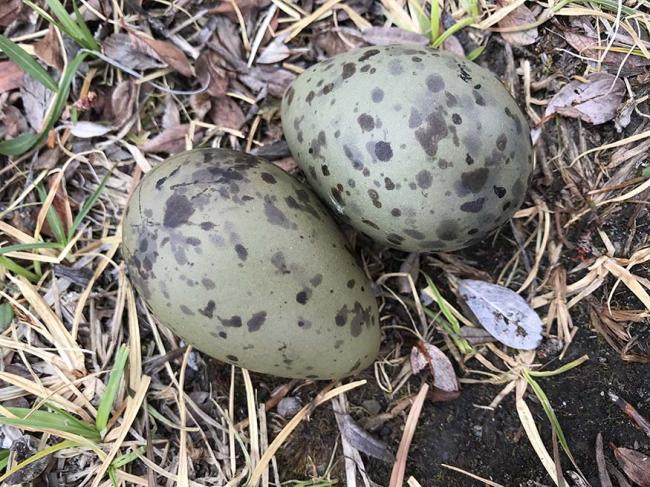
July 8-11: Here comes the storm
Storms in the Arctic generally mean extremely high winds. Some winds can reach so high that they are classified as hurricane force winds. Luckily, nothing like that has occurred here so far, but we did have a storm that would soon be coming through.
On July 8th, Kurt thought it would be best if we took the boat out of the water and stored it for the storm so that we would not have to go constantly check on it and worry. We managed to get the boat out pretty easily, and then we ran it over to a building to rinse the salt water off of the motors and the boat. The rest of the day was spent cleaning up after our boat trip, relaxing, and picking out some movies for when the storm arrived.
I forgot to mention some of the benefits of the air base, and I figured I would explain a little bit about what else it has to offer. There is a community/recreation center that has movies and books to rent, a room for art/carving/etc., an arcade, and a café. The center also offers activities like ATV rides, group climbs and hiking, and more. Generally, we are already busy and are having fun on our own as a team, but it is cool that they offer these opportunities to everyone on the base.
There is also a gym on base – and a pretty great one! There’s a bowling alley, pool, basketball court, racquetball rooms, a cycling room, yoga room, Crossfit and climbing room, massage and relaxation room, and the typical lifting and cardio areas! This little blurb is not necessarily relevant to the work we are doing and what not, but it is always fun to educate and share what I am learning about where we are staying!
On July 9th, we woke up to the first storm of our field season. It was raining and the winds were reaching up to 30-45 knots. I spent the day inside doing some data input of the measurements and bandings of the passerine traps, journaling, and blogging. We snuck some movies in there (and meal of course). I had some time to catch up with family and friends back home, too!
July 10th was the same as the bad weather was clinging on to the base. A good amount of chocolate and movies were gone through once everyone had made sure that there were no other little chores to do for the boat or on the base. Kurt and I ran to the gym to get moving since we were stuck indoors. Other than that, there was little to do today except for to get excited for when the weather would calm down.
On the 11th, some of our wishes came true! The winds had slowed enough for Alex and I to trap passerines until just after lunch. We trapped about 30 birds in a pretty short amount of time! After lunch, we continued to take advantage of the calmer weather, and so we went looking for a pair of parasitic jaegers on base. Close to the edge of the Wolstemholme fjord, Kurt spotted the pair and we eventually found the nest!
This was only my second time seeing jaegers. They were different to me because of their dramatic and defensive personality, and they drew me in. Once anyone got close to the nest they would attempt to distract you and trick you into thinking the nest was elsewhere. The jaegers would also make different noises and swoop very close into you. Another act they do is they pretend to be injured on the ground and act as though their wing is broken or hurt. I kind of admired the hard work and intensity they put in to protecting their nest.
Even though the weather was calmer it was still pretty cold to be trapping, so we decided to come back another day to attempt and trap the jaegers to band and sample them. Alex was going to paint some fake eggs to look like the jaegers so that we could keep their eggs safe while trapping.
We grabbed dinner when we got back. I went to the gym for a little bit to get some more energy out before reading and heading to bed!
July 5: Team Selfie!
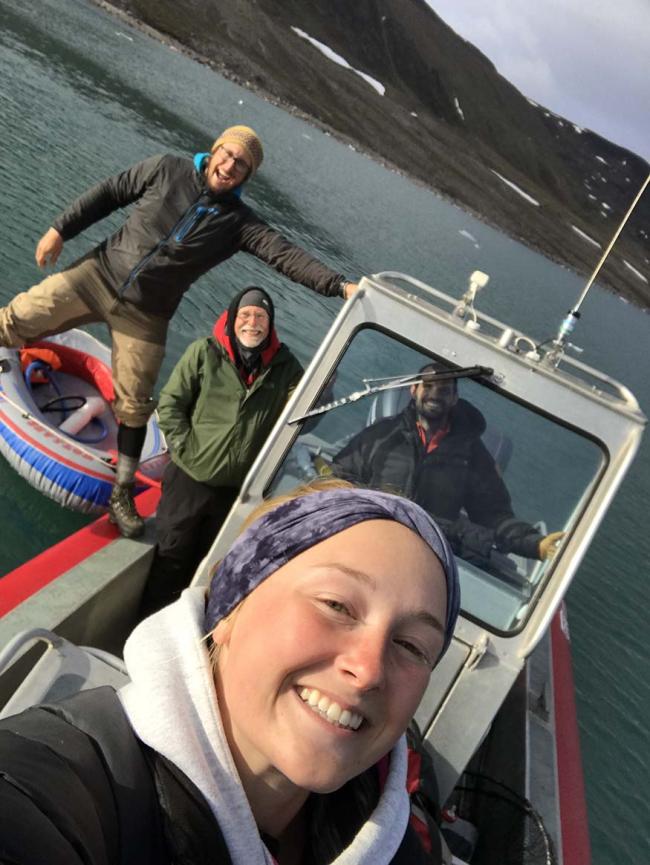
The 5th and 6th of July were another couple of days full with a bunch of smaller tasks and excitement that led up to our next boat trip on the 7th.
The day after our boat trip on the 4th, I woke up feeling like a swollen monster full of wind burn and some sun burn. The rest of the team agreed that my face had lost to the strength of the sharp Arctic winds. For the majority of the day we relaxed and shared our trip details with Bridger, who had stayed behind with his injury.
While we were on the boat, Doug had arrived in Thule. Dr. Douglas Causey is a professor at the University of Alaska Anchorage. He has been to Thule for research previously with his interest in seabirds, especially. He would be here for two weeks to work with us and join in on the team’s trips! ake-out from the restaurant, Top of the World, and movies concluded our relatively lazy day to replenish our bodies before some more hard work.
On the 6th, we woke up to a cold and gloomy morning which seemed fitting as we had to say good-bye as Bridger would be hopping on his flight home in a couple hours. Although none of us wanted to see him leave, it was good for him to get home to rest and heal.
Kurt, Alex and I then started on our list of things to do for the day because we were planning on leaving for another boat trip the next day. While we ran through the list, Alex and I were also running traps for passerines on base. After only catching a handful of birds, the traps were closed due to the wind and rain that showed back up even though it was uninvited.
Laundry, truck washing, dingy fixing, and sample kit preparing kept us busy until we all went to fill the boat up with gas in the small boat harbor. Again, we ended with a laid-back night in the barracks which was filled with Ben and Jerry’s ice cream, a game of darts, and a movie.
To the boat! On the 7th, we had a 5 a.m. start on the day and this time with our teammate, Doug. The start of the trip was full of cliff surveying from the boat up until we made it to Cape Atholl. There, Alex and Kurt were dropped off to retrieve one camera and place another.
Once everyone was back on the boat, we took off for another island, the Witch’s Tit. As we pulled up we could all immediately see the island booming with common eider ducks, black guillemot, glacous gulls, and black-legged kittiwakes. If you looked carefully, you could even see a few Atlantic puffins!! Kurt did the honors of hopping onto the island with the dip net to catch whatever he could for us on the boat to band and sample.
Considering the cooler weather, rocking boat, and smaller working space on the boat, we felt pretty good about how many birds we handled! Today was the first day I had worked with common eider ducks, too! After working with a few common eiders and black guillemots, we went to our next stop at Mansen Island to survey the island.
With calmer waters and ice far enough to keep us worrying, we were able to anchor the boat and everyone got off. As I walked the island I witnessed TONS of common eider nests. Each one was surrounded with common eider down (incredibly soft and the most expensive down in the world) to keep the eggs warm and protected. During this part of the trip we also found a pair of parasitic jaegers and some snow geese nests – one of which had eggs that were beginning to hatch! The team had a nice break back on the boat in the glassy ocean waters, and we filled ourselves with warm drinks and tons of snacks before heading to our final location for the trip.
Brian’s Leap was a cliff location that held the nest of gyrfalcons. Upon arriving at the edge of the cliff face after climbing up, I could hear the gyrfalcon young and got excited knowing that Alex and I would be able to sample and band them! Kurt rapelled down into the nest, removed and placed a new camera, and handed the three fluffy balls (the gyrfalcon young) down to Alex and I to proceed. After safely placing them back in the nest, we walked back down the cliff to the beach and got back on the boat. On the ride back, we surveyed more cliffs along Wolstenholme fjord and we were graced with the presence of a bearded seal sitting on some ice just 5-10 feet from us! It must have liked Kurt’s boat music because it did not swim away as we slowly approached for pictures and amazement. Perfect way to end our trip! We made it back just after midnight, and I made myself some spaghetti before happily going to bed.
July 4: "Captain" Bailey
Before kicking off this next blog, I would like to remind everyone about the 24-hour daylight we experience here in Thule. During the summer time, the sun does not even touch the horizon. It just circles up in the sky above you as the hours go by – pretty dang cool... With this advantage, it allows the team to work at any time and as long as we need to!
On July 4th (Happy 4th of July!), there was a knock on my door at 4:45 a.m. and that could only mean one thing! Go time! Kurt, Alex and I untied the boat — Barb is the boat’s name by the way – and we took off for Granville Fjord. A beautiful, sunny boat ride and some music along the way passed the time quickly on the vast, open ocean waters.
Before anyone got off the boat, we surveyed some of the cliffs for signs of falcons. From the boat, we use our binoculars to search for potential nesting locations and actual peregrine and gyrfalcons. Looking for cliffs that are more protected by the strong winds, that can be reached by the summer sun, and that look stable with some grassy patches around we start our day searching for the fierce and beautiful falcons. Kurt was the first to get off of the boat at a cliff location named Ping, and he retrieved a camera from last year.
The cameras show pictures based off of either a motion sensor or time lapse. With these photos, we are able to see when falcons arrive and leave, when the eggs are laid, when they hatch, what predators might show up and what types of food the falcons are bringing in.
After our stop at Briffin (another falcon cliff), we boated to Moriusaq. Moriusaq is an abandoned village a relatively short distance outside of Thule. It is common in the Arctic for villages to be abandoned once the population has reached below about 50 people. With such low numbers, the government decides to have people relocate. The government provides supplies to these Arctic communities, but when they reach below a certain population number they have to move people due to the expensive process of bringing the supplies to that area.
In the village, you can still see the abandoned houses, church, and school. There are still huge amounts of personal belongings, school supplies, and the church looks as though it had been used just recently even though it had been left about 10 to 15 years ago. This part of the trip was something very different, and I feel important to experience as this is not something that is seen in communities less remote.
There was a peregrine nest close by to the village that we moved on to next. This is where I became the “captain” as I dropped off Alex and Kurt to head to the nest site to attempt to capture a peregrine falcon and retrieve a camera from last year. At this point, my job was to simply man the boat. We cannot leave the boat anchored alone in many places with the tide cycles, wind patterns and moving ice bergs. I would have to say did a great job looking after the boat and picking up Kurt and Alex when they finished up their work!
They were unable to capture the falcon, but they were still able to retrieve the camera. With the winds picking up and some rain settling in, we headed back to base and arrived around 2 a.m. (remember what I said about 24-hour daylight!). We managed to squeeze in a big spaghetti dinner before falling asleep after a long and productive day!

July 2: Off we go!
Back to the early morning rise and breakfast – the ice had cleared from the beach, and we were all set to get on the water after lunch.
Getting the boat into the water was a task that was more troublesome in the past, for the team than I would have imagined. There were many parts to consider, such as the quality of the boat ramp (which was not in the best shape), whether the water was at high or low tide (we waited until high tide), the truck that was carrying the boat and its condition, and the weather at the time.
Even with the many things that could have gone wrong, it went smoothly! We loaded all of our packs and gear onto the boat and took off for Saunders Island.
I had already been feeling all different types of joyful and peaceful emotions since arriving in Greenland, but that first boat ride brought me so many emotions all at once. The ocean, icebergs, islands, wildlife and everything around me was stunning. I worked to hold back some tears of happiness as they welled up in my eyes. I could not stop looking around me.
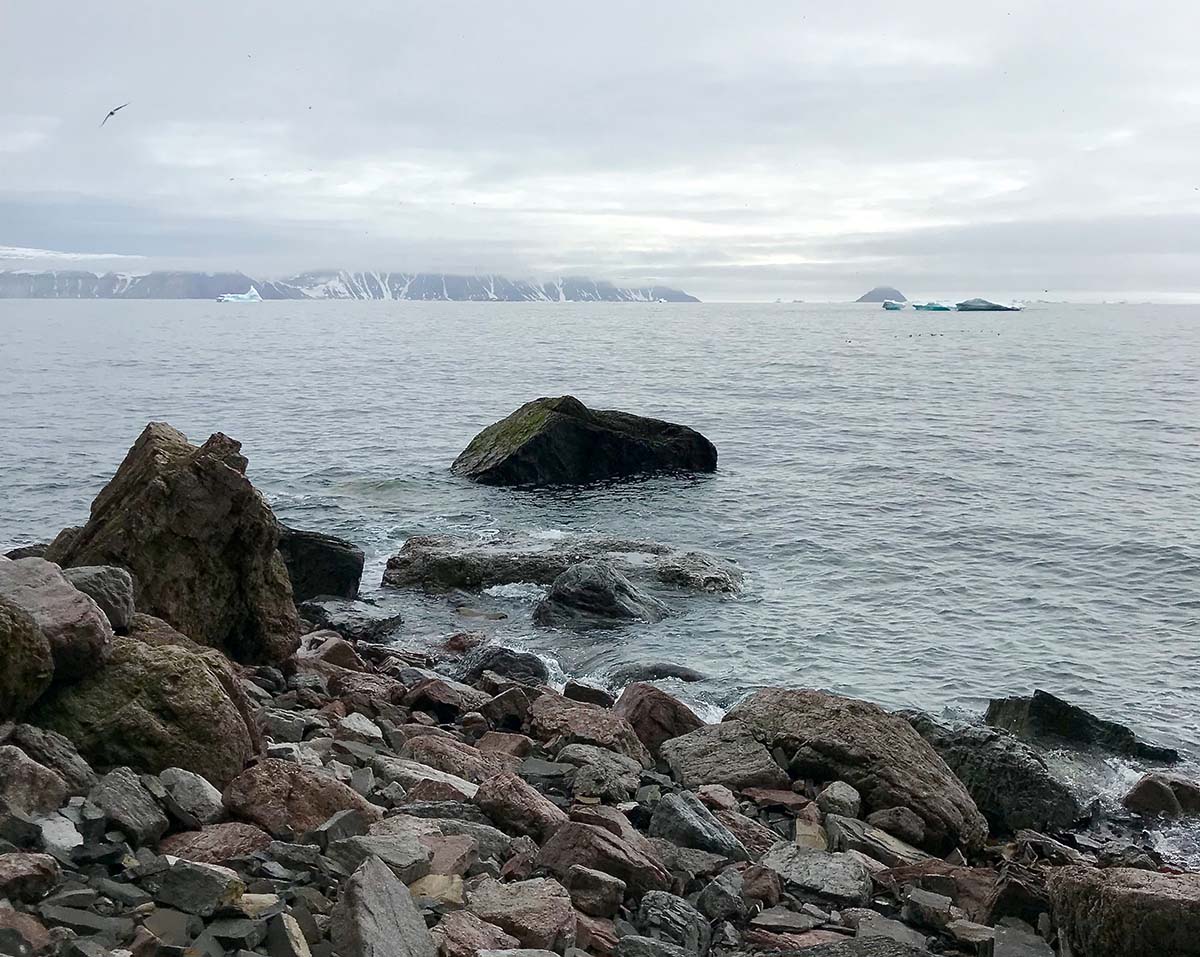
Once we reached Saunders, we followed Bridger with how to get off of the boat and onto the island. Kurt then went to anchor the boat and used the dingy to paddle to shore to meet us. We were on a mission to catch as many black guillemot and black-legged kittiwakes as possible!
Bridger got right to work with the dip net, and soon we couldn’t keep up with him – he was catching so many birds than the speed at which we could band and sample them! Alex and Kurt would color the birds' feathers with orange and red markers in order to make sure Bridger wouldn’t go off and catch the same birds again.
This process definitely looked funny, but it worked and the color would fade very quickly from their feathers. We had a productive start to our afternoon, and we decided to move around the corner a bit to switch it up and catch some more.
On the way to the boat there was a little mishap. Bridger accidentally slipped and was pretty sure he broke his arm. After many, many years in Thule, the team had never had any big injuries until now, sadly. We hurried back to base so that Kurt could bring Bridger to the hospital, and they soon had him all fixed up and much more comfortable in a cast.
Unfortunately, Bridger would be going back home on the next flight. He was such a huge asset to the team, so we had a bit of rearranging to do. Kurt and Bridger had taught Alex and me a lot since arriving in Thule, so we were sure that we could keep going strong with our field work. We were all very sad to hear that Bridger would be leaving us soon, though. I loved getting to know him as a mentor in the field and as a new friend!
The rest of the night, I relaxed, ate a lot of cheese and crackers, and watched a movie before easily falling asleep after my first day on the boat.
June 27: Trapping and exploring
Over these few days we were in a waiting game with the ice and the boat launch. We needed to have the ice clear out more so that we could get the boat into the water. We still had plenty of things to do on base, but everyone was getting antsy to get on the water.
Alex and I worked on trapping passerines with Kurt and Bridger until they felt we were confident to work on our own. Through this process, I was able to retrieve birds from the traps by myself! After some practice (and a couple times of accidentally letting them go), I felt really good with retrieving the birds on my own.
Alex would process them, and I would assist with the documenting and preparation. We are a good team, and have fun together laughing at whoever gets pooped on by the birds and my slip-ups with driving stick shift as I work to get better! AND, we have been catching lots of birds!
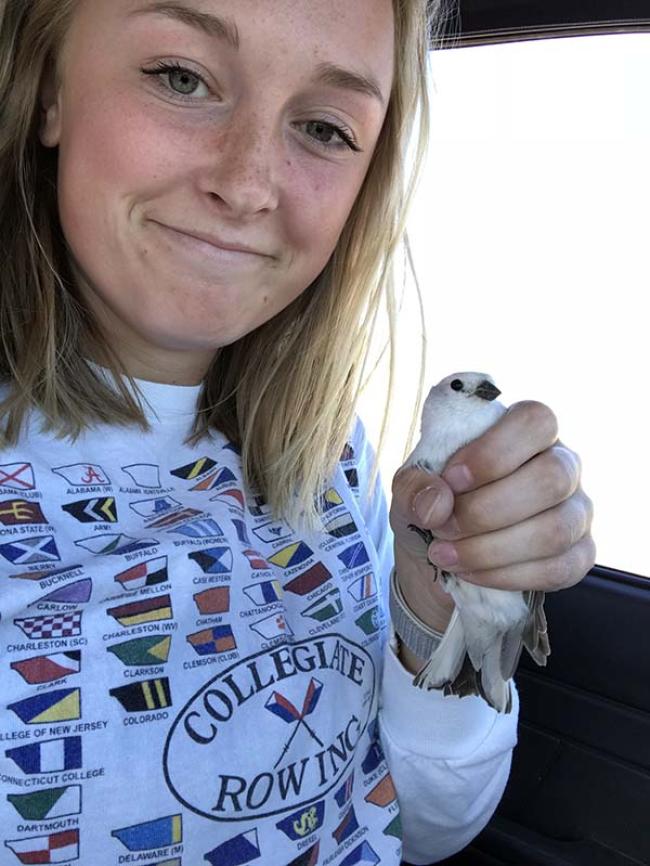
Other than trapping, Bridger, Alex and I went out to survey South Mountain for any signs of falcons. We did not find anything, but we had a beautiful and sunny hike along the Fox River. It was a nice hike to loosen up the muscles after the crazy Dundas hike!
Another crazy afternoon adventure led to exploring D-Launch – an abandoned missile holding that was used during the Cold War. Now, we could actually go down into the holdings where the missiles are held by crawling in or going down a ladder from above the holdings.
It was completely dark and iced over. The guys had headlamps so we had the chance to look around and see the chains that moved the missiles that were still in there, and they were now held down by layers and layers of ice! That was surely something I never thought I would have the chance to explore in Greenland, let alone my lifetime.
I was also lucky enough to learn how to play racquetball by none other than the best – Kurt and Bridger (I am sure they would love to hear me say that). We had a good time, even though they beat me by so much that I lost count!
The rest of the time leading up to our first boat trip consisted of sampling and boat preparations, World Cup games, movies, gym trips and tracking down the Arctic fox kits around base. We are all more than ready for our first time out on the ocean!! I can’t wait.
June 26: Been there, Dundas
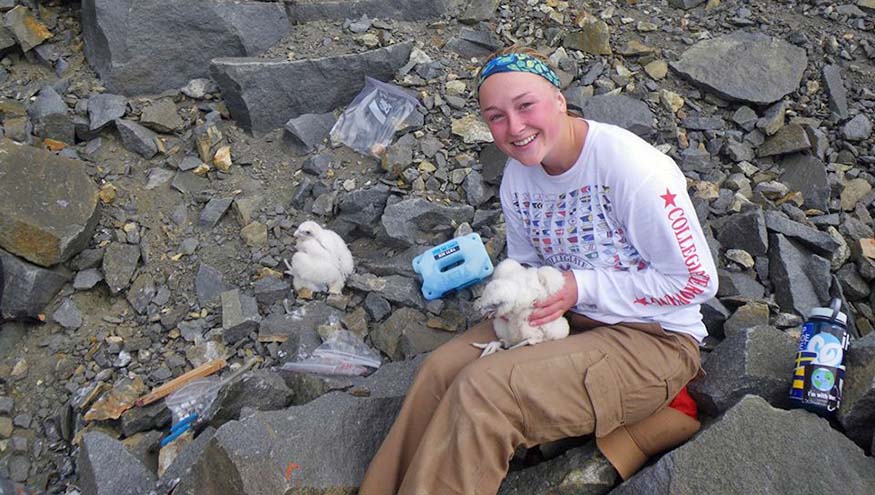
Some breakfast, light packing, and we were out the door for Dundas Mountain! Dundas is actually not located on the air base, so this was my first time off of the base in Greenland.
We got to the base of Dundas, and I looked up. Uh oh, I thought in my head. It looked quite a bit bigger and steeper than from what I remembered looking at it from a distance, and this was before I was carrying a heavy pack.
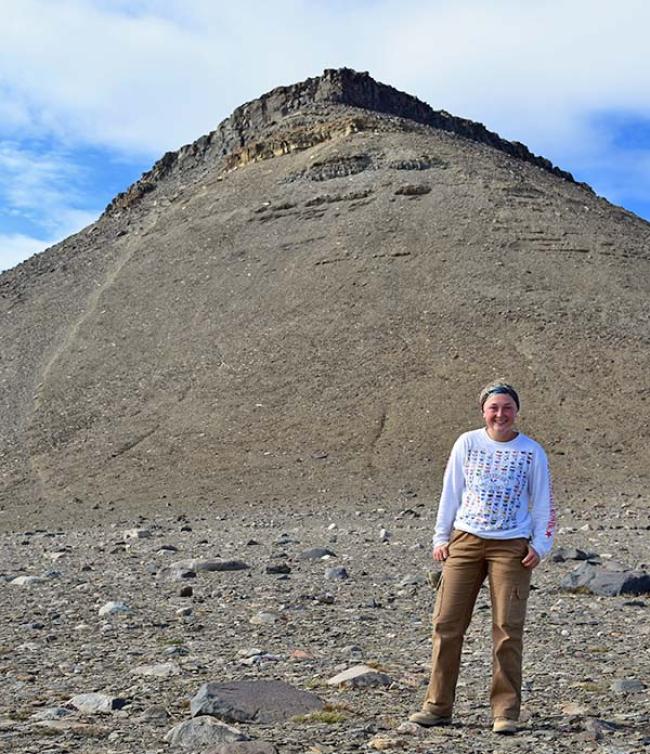
I walked to the base of Dundas with determination, and even though I trailed the team by a good amount, I MADE IT. Dripping with sweat and dirt, I had to lose a couple layers and then we made our way around the mountain on the slick and crumbling rocks.
Our first stop was at a gyrfalcon nest, and we had the opportunity to band and sample some gyrfalcon chicks! This was my first time seeing a gyrfalcon or gyrfalcon chicks, so it was a treat. They were fluffy little chicks, and Kurt even let me hold one for a bit!
Next, we moved on around the mountain on the lookout for a peregrine nest. Bridger retrieved a camera that was placed in the peregrine nest from last year. We found a pair of peregrines, but we did not have luck finding a nest that they could have been using this year.
After a while of looking, we decided to head back down Dundas. I felt a lot more comfortable going back – the sun was shining, and I felt great! I ended up slipping and sliding most of the way down Dundas on the dirt and loose rock, but nevertheless, I got to the bottom where Kurt, Bridger and Alex were lying on the ground in the sun. And I joined them with a snack in my hand.
On the way back to base, we saw a bearded seal relaxing on the ice in the sun. It seemed just as happy to see the sun as we were! I took a nap before dinner, and after that we hit the arcade on base for some air hockey, basketball and competition! A fun end to our day full of adventure and hard work.
June 25: On the cliffs
Our trip to Dundas mountain was pushed back another day, and so we had our first day of trapping passerines (perching birds) on base. We use potter traps on base, and we put seed into the back to entice the birds into the trap.
Once a bird is trapped (snow bunting and Lapland longspurs), we retrieve them, band them, take measurements and release them. This includes measuring the beak, head, tarsus, wing, tail, weight, and then checking the fat and muscle amount and if they are molting or have a brood patch.
The four of us went around to the traps every hour, and I had a great time with the process — again, I learned a lot and was very interested in how the measurements and banding process went. Soon enough, I would be retrieving the birds from the traps!

The day got even more exciting... Bridger told Alex and I that he would take us out to rappel and jumar off the cliffs if we were interested... That was not even a question. OF COURSE I WAS INTERESTED! Especially the chance to do that over a fjord in Greenland. I mean who could pass that up?!
We went back toward the Secret Place and found a nice cliff to get started on. Bridger went through all the basics, from set-up to safety, and he even went down alongside of me to make things easier and more comfortable. WOW. The whole experience was jaw-dropping.
Of course the rappelling down was great, but it was even better when I looked behind me and saw the fjord and glacier... I could not believe my eyes. I chose to go all the way down the cliff, which I realized was a small mistake because I was going to jumar (climb with the aid of a clamp) back up. Bridger had made jumarring look easy, and it was most definitely not easy!
I was laughing as we started to jumar back up because I realized that I was in for the ultimate challenge. Bridger was more than encouraging and was very confident in my abilities, but I had some moments of doubt as I was dripping sweat making my way up... I made it of course, and I could not have been more proud! I was so thankful that Bridger took us out to experience that. It was incredible!
We all made it back just in time for a huge dinner at the Dundas Buffet (which was well-deserved). Today was an exciting day, and tomorrow should be the same with our trip to Dundas Mountain!
June 24: Peregrine X 2
Yesterday (June 23) was a fairly relaxing day with the cold weather, and the most important part of it was prepping the boat for when the ice clears from the bay.
Today we headed back to the first peregrine nest, and we were on a mission to catch the first peregrine! It was a quicker process as we knew where the nest was, and we all got set up pretty quickly. Alex and I went off to hide after everything was set, and I was "mama bird" for today (I kept the eggs under my shirt in the incubation box since it was a bit colder today.) It only took about 30-40 minutes before we were successful!
Alex and I quickly hiked down the cliff so that we could help out with the banding and sampling of the peregrine falcon. I recorded as I watched the process, and we moved quickly so that we would cause the least amount of stress on the falcon. Soon it was time for me to hold the peregrine for the first time... and YES I WAS NERVOUS. I was excited, too, of course, and I couldn’t stop smiling. They let me have the honor of releasing the peregrine, and then we went on our way back to base for lunch.
After lunch, we went back towards the Secret Place in hopes to find another peregrine nest. We started the process the same as before with being extremely quiet and then making noise when we had our eyes on all locations. We found the nest and got back to the process for capture. When the peregrine was back on her nest I had the chance to be the one to toss rocks for some noise and yell “GET UP! GET UP!” She was caught not too long after, and Kurt and Bridger banded and placed a geolocator on the falcon from the bottom of the cliff. Two falcons for today... I would say we had a productive day!
Kurt, Bridger, Alex and I stuffed our plates full of food once we were back after our busy day. I would say I am definitely keeping up with the guys on these big meals!! Now I just need to work on keeping up on the hikes... :)
June 22: Our first full day
After breakfast we embarked on our first attempt to capture the first peregrine falcon of the field season! The terrain is generally rocky, so I was still getting used to moving myself around to each location... and this meant I usually found myself at the back of the group for reasons of me learning how to move quickly on the rocks and because I could not keep my eyes away from the views!
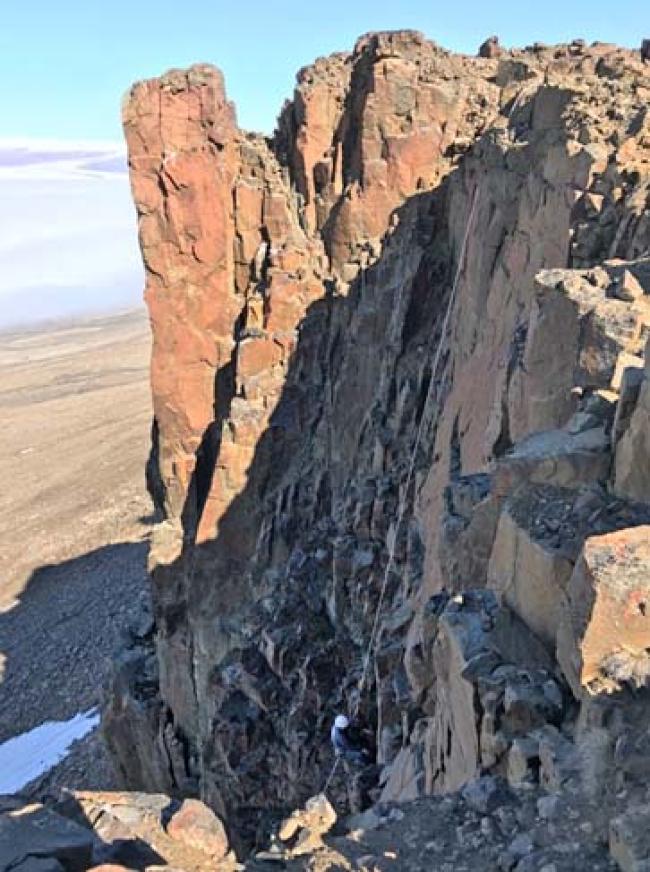
It was very interesting to see how the process went with out to locate the nest and capture the falcon.
While approaching the potential nesting site everyone stays quiet, and then, when everyone has their eyes on different locations we make some noise to see where the peregrine flies out of to give us an idea of where the nest is. It did not take too long for us to find the nest, but we did not have luck today with the capture. Still, I learned A LOT today with how the capture works and the differences between a male and female peregrine falcon.
After the nest is located, Bridger (or whoever else is able) rappels down or walks up to the nest to grab the eggs and places them into an incubation box for safety. After they are safe, a noose trap and fake eggs are placed in the nest, and Bridger is hidden where he can have quick access to the nest when the falcon is captured.
Kurt is also hidden somewhere farther away, but where he can see the nest to radio to Bridger that the falcon has been caught. If everything goes as planned, the falcon will feel comfortable to go back to the nest, sit on the eggs we placed, and get her feet caught in the noose trap.
When she is sitting, we toss a few rocks on the cliff to make some noise without compromising our locations. Hopefully then she will get up and try to fly and tighten the noose on her feet and get caught.
From here, Bridger rappels down and grabs the falcon so we can band, sample, and place a geolocator (if needed). Since we did not capture the peregrine today, this will hopefully all go as planned tomorrow!
On another hike tonight, Bridger took us back near the cliffs by the Secret Place and we looked for possible nesting sites. We saw more wildlife which included a musk ox and Arctic fox kits.
June 21: Arriving in Thule
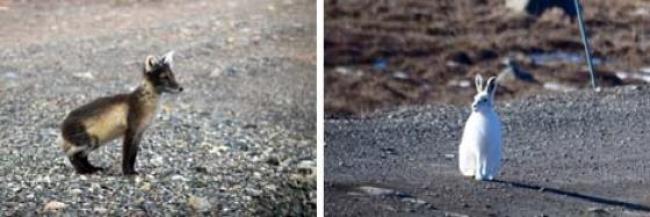
June 21 — Going in and out of sleep, I woke up numerous times to some incredible views. We landed on Thule Air Base around 8:30 a.m. and we had a full, sunny day ahead of us! After getting some paperwork done and going over some of the rules on base, we left for our barracks and got settled in a bit before getting to our to-do list.
The day went by quickly as we had a lot to do. With the 24-hour sunlight during the summer in the Arctic, we can get a lot done without the restriction on the time of day. Some of the list included getting the trucks and gear, picking up mail and groceries, setting up our gear and research room, putting together tagging and sampling kits, drinking loads of caffeine, and probably more that I might have been half asleep for...
I had my first experience with the Dundas Buffet, which exceeded any expectations on meals on the air base. Multiple main course selections, a full salad bar, soups, deli, tons of fruit, and many, many choices for desserts. Oh, did I mention the huge coffee and hot cocoa machine? Yes, it was confirmed that no one would go hungry on base.

Later on in the evening, Bridger (Konkel, field manager) took Alex and I on a short hike along \the cliffs on the fjord over North Mountain. The area was named the Secret Place. IT WAS BEAUTIFUL. We saw a number of different wildlife along the way including snow bunting, Arctic fox and hare, Canada geese, and even a seal way out on the ice in the fjord. What a great way to end an exciting and busy first day in Greenland!
June 20: Embracing the unknown
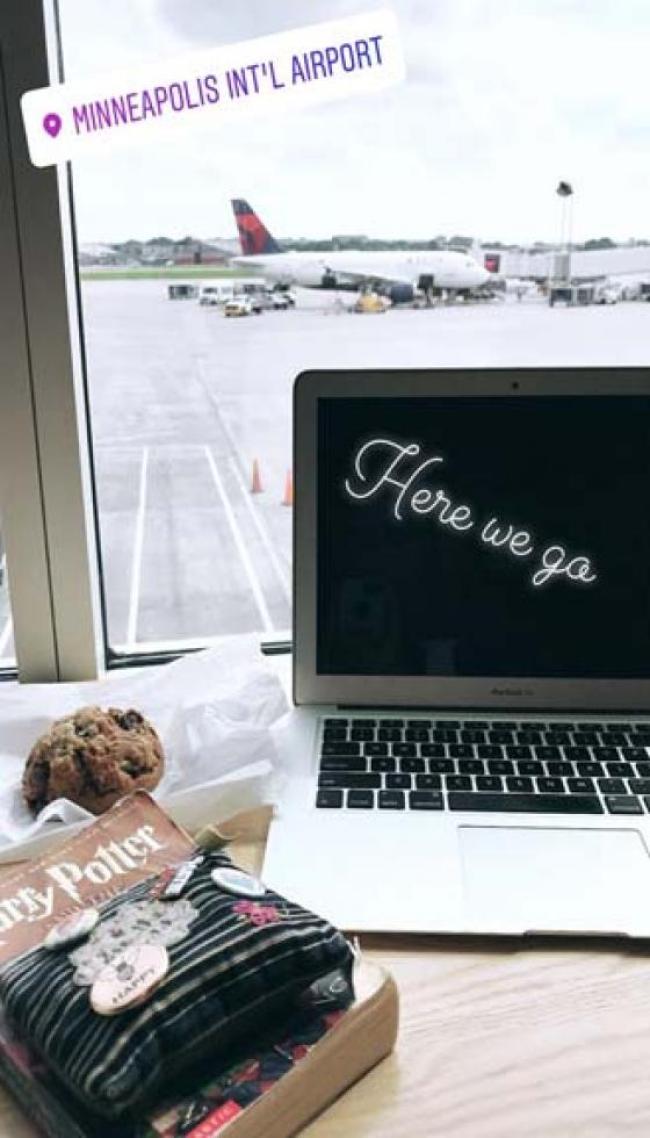
June 20 — Before leaving, I was asked to reflect on the trip ahead of me. What will Greenland look like? What will a U.S. air base look like? Will I experience different emotions? What wildlife will I see?
The list goes on and on. I knew that visually I would see things that I would not normally have the opportunity to see, but what would this entail? I did not expect anything except for this trip to be life-changing, as each trip I have been lucky to take has given me a different look on the world around me.
A goal that I set for myself for this trip to Thule, Greenland was to embrace the unknown that I would be heading into. Being in the unknown is a feeling that I have generally had a hard time with up to this point, and I have been working on changing this. As someone who loves to explore and adventure, I feel it is important for me to push myself into exploring and embracing the unknown more and more. Instead of thinking about what to expect in northwest Greenland, I will be thinking about the infinite unknown and how special it is that I have the chance to take on this incredible adventure.

